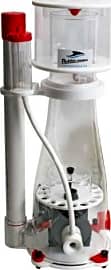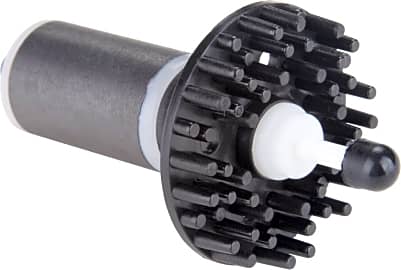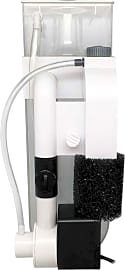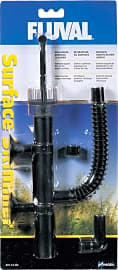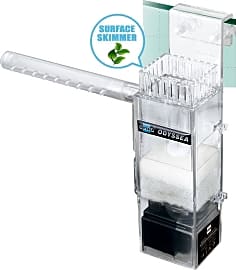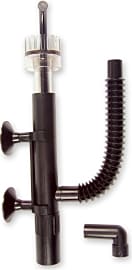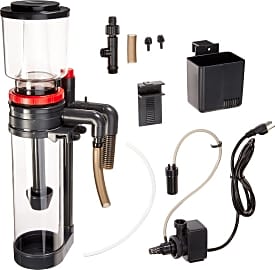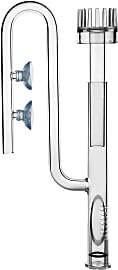The 10 Best Aquarium Skimmers

This wiki has been updated 32 times since it was first published in February of 2017. If you’re looking to rid your fish tank of accumulated gunk, debris, and oily residue, these handy aquarium skimmers will do the trick. By removing proteins and organic materials from the surface, they will improve water quality, oxygen exchange, and light penetration, leaving your aquatic friends clean and happy and creating a crystal-clear environment for your viewing enjoyment. When users buy our independently chosen editorial picks, we may earn commissions to help fund the Wiki.
Editor's Notes
March 16, 2021:
It was a straightforward round of updates for us, as almost all of our old choices managed to hold their own through today’s reevaluation. The only exception to this rule was the Eheim Skim 350, which we decided to remove after noticing that it wasn’t available at the time of this writing.
To replace this option, we added the IOAOI PS-180, which can handle tanks as large as 300 gallons. This option caught our eye with its handy, included controller, which makes it easy to adjust the speed for its pump, with 20 settings to choose from.
One thing that we did find a bit odd about this option, however, is that the controller offers a “wave” setting, even though there should really be no need for such a function with this device. Its an awkward inclusion, to be sure – probably resultant of IOAOI trying to double dip and reuse a design that was intended for wave makers – but we still thought this option was worth including on our list, as there should really be no harm done by this superfluous button, as long as it’s simply ignored.
For further aquarium accessories, perhaps you’ll be interested in perusing our rankings for air pumps, stands and thermometers.
October 17, 2019:
A reliable aquarium skimmer will improve the health of your tank’s aquatic life by effectively removing proteins and organic materials from the water’s surface. They’re designed to connect to canister filters for a system that keeps your tank’s water aerated and crystal clear.
Joining the selection today is the powerful Bubble Magus Curve 5, which is compatible with tanks of up to 140 gallons and features an SP1000 internal pump. It’s easy to position in virtually any aquarium setup, since the pump’s intake and outlet can be positioned either inline or perpendicular to each other. Its venture intake produces just the right amount and size of air bubbles, and its innovative, curved body allows the foam to rise smoothly to the collection cup.
The Aquatic Life 115 Mini Internal has been removed from our list amidst reports that it produces excessive bubbles and that salt builds up quickly in the air intake.
Special Honors
Pentair This company might be best known for their pool equipment, but they also offer a wide range of gear for aquariums. The biggest of their skimmers are capable of managing more than 3,000 gallons, making them a viable option for zoos and coral wholesalers. pentairaes.com
Coral Vue Aquarium Products This company's wide selection of skimmers includes a size suitable for virtually any aquarium. Its largest model stands seven feet tall, is backed by a two-year warranty and can handle up to 26,500 gallons of sea water. coralvue.com
Skimming Off The Aquarium Top
Aquarium skimmers are classified into both co-current and counter-current flow systems.
Sustaining aquatic life on a small scale is a big job depending on the species of fish swimming around your aquarium. In addition to providing proper filtration to a saltwater tank, an aquarium skimmer is an equally important tool for preventing the buildup of additional scum and dirt that could compromise the health of your piscine friends.
Also known as a foam separator, foam fractionator, or air-stripper, the aquarium skimmer is a mechanical filtration device specifically-designed to remove dissolved organic compounds, proteins, and other wastes from a saltwater tank environment before they have a chance to break down into more harmful elements, such as ammonia and nitrite. A skimmer also removes fatty acids, carbohydrates, copper, and other trace elements from an aquatic environment. Its operation results in many benefits, including a reduction of algae buildup over time, the removal of coral toxins, an increase to a tank's oxygen levels, and minimal need for frequent water changes. All of these factors support a tank's primary filtration system, while allowing it to function more effectively.
Three main components to the aquarium skimmer include a body, where most of the contact between the dissolved wastes and water takes place; a foam separation area (also known as a riser tube), responsible for isolating the organic-laden foam and its dissolved compounds from the tank water; and a collection cup, where the foam spills over the riser tube and essentially drains away.
When water first enters and flows through a skimmer's main body, it comes into contact with a column of fine bubbles. These bubbles are responsible for collecting the proteins (and other substances) from the water and carrying the contaminants to the top of the device and to the collection cup where they can be easily removed. Aquarium skimmers rely on the chemical process of adsorption and the use of micro-bubbles to remove waste byproducts from a saltwater environment. A high concentration of small bubbles occupying a space within the skimmer's water column offers a greater surface area for the adhesion of organic molecules, as opposed to large bubbles.
Aquarium skimmers are classified into both co-current and counter-current flow systems. In a co-current flow system, air enters the skimmer from the base of the device, while maintaining constant contact with the water inside as it flows up the water column toward the collection cup. With a counter-current system, pressurized air is forced into the device by use of an air pump and it continues to rise against the flow of water until it reaches the collection chamber. In this type of system, air bubble contact with water is maximized to ensure superior contaminant reduction.
Common device types include air stone, Venturi, aspirating, downdraft, and Beckett skimmers. The aspirating skimmer leverages a modified impeller to chop air into extremely small bubbles. It has a very slow water flow, produces large amounts of foam, and is relatively inexpensive to operate. Downdraft skimmers utilize a high-velocity jet responsible for spraying water into a column containing specialized media called "bioballs". These bioballs effectively disrupt the jet spray in order to form bubbles. Once the bubbles have passed through this column, they enter a sump box where they are directed upwards to the foam collection container in the neck of the skimmer. The Beckett skimmer is similar in design to the downdraft variety, but it uses a foam nozzle to produce its flow of air bubbles instead.
Dependable Control Over Your Fish
Think of an aquarium skimmer as a first step in the filtration process when considering its placement in your tank.
On the subject of balance, placing your skimmer above the water line is also a good thing when the water level fluctuates from time to time.
Next, you'll want to ensure superior control over the skimmer's water level by using a dependable gate valve. Keep in mind that if the water level is too low, the skimmer won't remove much from your tank environment. By contrast, if the water level is too high, the device could remove more water volume than may be necessary. A sturdy gate valve will help to solve this problem by maintaining a proper balance between your skimmer and the other filtration methods your tank is utilizing. On the subject of balance, placing your skimmer above the water line is also a good thing when the water level fluctuates from time to time. Keeping the device above the water line ensures its own output remains constant.
Skimmer maintenance is definitely something to keep in mind, as well. Most models require at least some amount of monitoring and attention. The questions to ask yourself when purchasing the appropriate skimmer are how long you want to spend cleaning the device and how often that should be done. Skimmers with large collection cups, for example, (and those with built-in drains) won't require emptying quite as often as those with smaller cups. Finally, pay attention to the arrangement of a skimmer's individual components, while making note of how easy they'll be to access when maintenance is required.
A Brief History Of Aquarium Skimmers
The hobby of reefkeeping dates back to the times of ancient Rome between 37 B.C.E. and 400 C.E. Freshwater fish were kept in marble boxes and placed in guest rooms as a representation of the fish that could later be consumed at elaborate feasts.
Naturalism was of great interest in 19th century Europe, so people began to experiment with keeping live fish, corals, snails, and other animals in primitive aquariums.
Practical popularity for maintaining aquariums occurred centuries later during the 1800s. Naturalism was of great interest in 19th century Europe, so people began to experiment with keeping live fish, corals, snails, and other animals in primitive aquariums.
Technological advances of the early 20th century included the invention of the first water pump. The aquarium skimmer first appeared in the early 1960s as a result of an observation made by a German hobbyist who noted the formation of brown foam inside his under-gravel filter. He used a series of celluloid tubes connected to an inclined tube in order to drain the foam into a cup. The first commercial protein skimmers also appeared in the 1960s, followed by one of the first motorized Venturi skimmers in 1981.
Today's skimmers incorporate compact designs, quiet operation, and the ability to aerate home-based aquariums, ensuring extended lifespans for an eclectic variety of saltwater fish.



